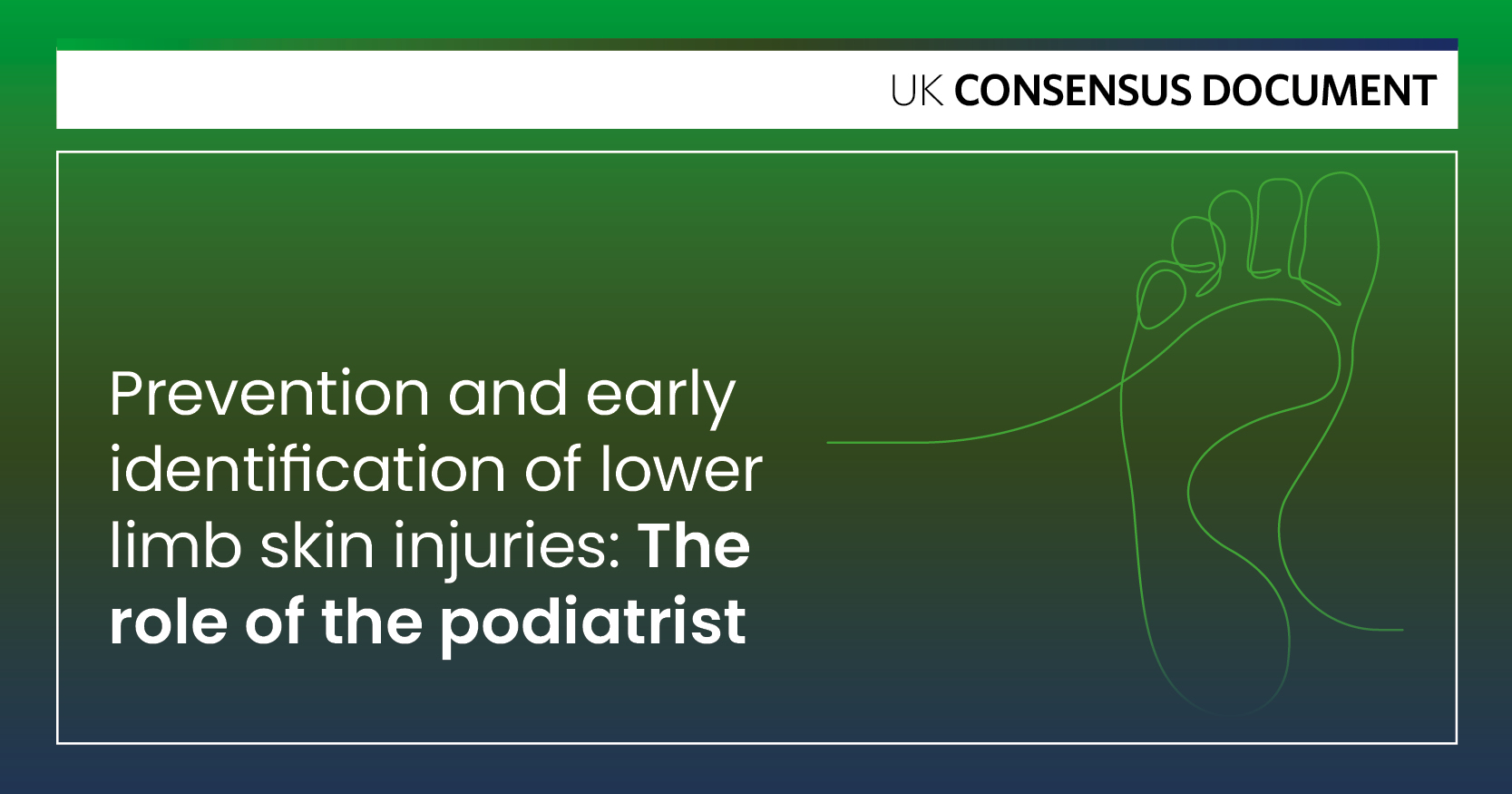Do you remember where we were 10 years ago? Clipping and chipping in long white coats and still called chiropodists or ‘shiropodists’ by most. Doing lengthy, complicated neurovascular assessments or nifty scalpel work to impress our medical colleagues and using adhesive semi-compressed felt pads around foot ulcers and trying to wean ourselves from splashing on Friar’s Balsam, hydrogen peroxide or inadine ointment on every sweaty foot or open wound! Those were the days!
The multidisciplinary team
Over the last 10 years, the podiatrist has evolved into a key member of the diabetes multidisciplinary team. No single podiatrist or other member of the healthcare team in the UK can deliver effective care for any people with diabetes in isolation from their multidisciplinary team. The medical and nursing champions of such teams have been and remain our greatest allies. There are now a number of centres of excellence across the UK where dedicated and established multidisciplinary clinics exist. The emergence of multidisciplinary foot teams was evident ten years ago – King’s College Hospital and Manchester Royal Infirmary were putting on regular foot conferences and The Diabetic Foot Journal was starting up as the enthusiastic new kid on the block.
The dissemination of ideas and inspiration from the established pioneers mentioned above was resulting in the emergence of more NHS podiatrists and podiatry posts being linked to diabetes. The team in Salford published their experience of setting up an integrated approach, directly linking their hospital team to specialist clinicians based in that strange and scary place – the community setting. ‘Diabetes-specialist podiatrist’ posts were being advertised every month in our professional journals.
As we move through the last decade, a number of other drivers started to shape the development and direction of both podiatry and other foot interested clinicians working in diabetes. CREST, NICE and SIGN all produced evidence-based guidance. The National Service Framework for diabetes appeared, clinical governance frameworks started to impact on the management of NHS podiatry services, resulting more recently in the carrot or stick (depending on your viewpoint) that is Standards for Better Health (DoH, 2004). We started to benchmark our services against this guidance.
‘Diabetics’ started to be called ‘people with diabetes’. The blame culture of labelling people as ‘non-compliant’ started to be replaced by an awareness that ‘non-concordance’ was the real issue, which has made us think twice about doling out repetitive advice, when we really need to be learning additional techniques in listening and communicating effectively with people with diabetes; such as those used in motivational interviewing or cognitive behavioural therapy.
Structured, population-wide foot-screening programmes started springing up, often led or provided by podiatrists. Prevention rather than heroic attempts at salvage started to become more part of our core business.
Over the past decade in locations such as Southampton and Tameside, podiatrists have forged new working relationships with vascular teams, which have helped to dispel the common notion that podiatrists cause harm to the ischaemic foot. These relationships have resulted in podiatry-led integrated triage and care models that have been recognised at a national level (Hawksworth, 2005; Bowen et al, 2007).
A small but noteworthy anecdote is that recently in the South West, a podiatrist has been encouraged by the vascular team to apply for a post formerly held by a Vascular Specialist Nurse – truly acknowledging the potential of podiatrists to function at a specialist level within the team. Consultant Podiatrist posts focused on diabetes have been created in Northampton and North Manchester, and in Scotland a National Diabetes Foot Coordinator position has been created and filled by a podiatrist. The recognition for the creation of such a post is to be welcomed and really helps to place the diabetic foot on the political health agenda. The creation of this post was highlighted in the The Diabetic Foot Journal and we look forward to the results of this exciting initiative (Stang, 2007).
What about absolute outcomes? Following the groundbreaking impact on amputations demonstrated in the 1980s by the the King’s College Hospital team (Edmonds et al, 1986), in the last decade teams in Ipswich and Salford have presented data on their lower limb amputation rates that the rest of us need to aspire to (Rayman et al, 2004; Chadwick and Young, 2006; respectively). As with King’s College Hospital, a key factor in these latter successes has been the presence of pioneering and dedicated specialist podiatrists.
Minimum skills for podiatrists
Despite such national recognition of specialist podiatry within the multidisciplinary team there remains no defined formalised route to get there. We can all think of a few iconic diabetes specialist podiatrists in the UK, but no one can tell us how exactly to get to their level of knowledge and skills. There have been increasing numbers of ‘bolt-on’ courses, with varying degrees of recognition or validity, such as the Warwick Diabetes Course, various Masters modules in diabetes, the Society of Chiropodists and Podiatrists diabetes course, and other short courses.
The National Minimum Skills Framework for Commissioning of Foot Care Services for People with Diabetes (FDUK et al, 2006) goes some way towards defining what minimum skills health care providers now need. What is clear is that now is an opportune time for podiatrists with the drive, passion and interest to develop themselves in diabetes to acquire and provide many of these skills. Foot screening, vascular assessment, casting, wound care, prescribing and structured education are all skills that podiatrists wanting to work in diabetes need to consider. They are all skills that more and more podiatrists working in diabetes over the last 10 years have started to develop, practice and to some extent lead on.
Although it is not known how many diabetes podiatrists there now are around the UK, many thousands attend the diabetic foot conferences, have joined organisations such as FDUK and subscribe to journals such as this. A small but growing number are actively contributing to the speciality that is the management of the foot in diabetes. It is essential that key organisations in diabetes work in partnership with clinical champions in diabetes. These stakeholders must work in alliance with institutes of higher education to define a national curriculum for diabetic-foot specialists. Such a curriculum is fundamental to the future provision of an appropriately informed and skilled workforce of diabetes foot care specialists.
Sadly the ideal of nationally recognised specialist routes for footcare specialists lacks required funding to secure the implementation. Indeed it is a disgrace that the delivery of such an initiative lies with only a handful of clinicians who are passionate and driven and are funded by soft monies from pharmaceutical and dressing companies. The government must be made aware of the urgent requirement to recognise this shortfall in funding and attempt to secure future nationally recognised routes of training. Without this training, we may not be delivering optimum foot care. Surely with the advent of clinical governance, we need to address this significant problem.
The future
So what of the next 10 years? The elusive post-graduate route to becoming a diabetes specialist podiatrist perhaps needs to be looked at in a different light. Podiatrists, nurses and doctors wanting to become diabetic-foot practitioners have a core range of identified knowledge and skill areas that they can all develop competence in to enhance their multidisciplinary teams for the needs of an ever-growing population with diabetes. These multidisciplinary teams will be required to provide a much broader range of interventions to the whole diabetes population in a much broader range of settings. One thing is certain – thanks to the pioneers of the previous decade, there is a place for the interested and increasingly skilled podiatrist wherever diabetes care will be delivered.





